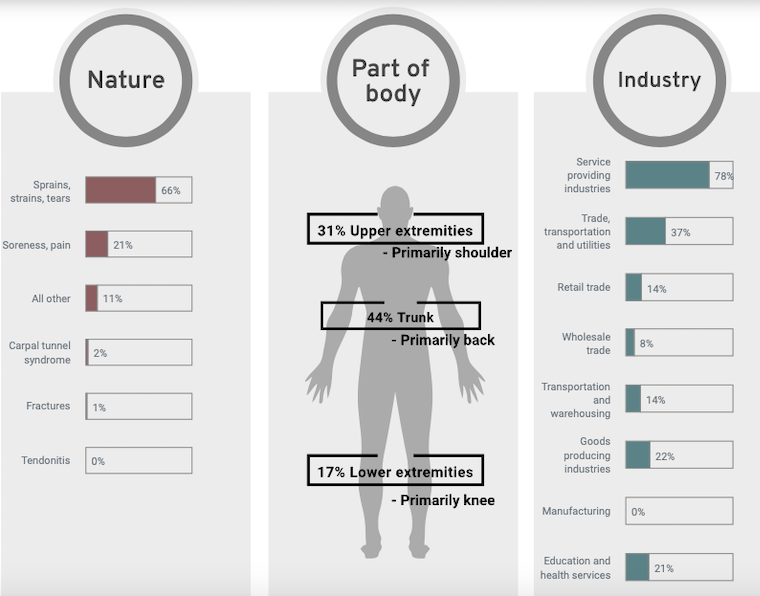Workplace Safety

June is National Safety Month, and the National Safety Council has provided the following facts regarding workplace injuries:
Over-exertion and bodily reaction
Overexertion and bodily reaction is the leading nonfatal injury event involving days away from work, representing 31% of all such injuries. This category includes several types of injury events:
- Non-impact injury or illness resulting from excessive physical effort directed at an outside source of injury or illness. Common worker activities include lifting, pulling, pushing, holding, carrying and throwing.
- Injuries or illnesses resulting from motion that imposes stress or strain on some part of the body due to the repetitive nature of the task. There is typically no strenuous effort (such as heavy lifting). Common worker activities include typing, texting or using a mouse; or repetitive use of tools such as screwdrivers or hand tools.
- Injuries or illnesses resulting from a single or prolonged instance of free bodily motion. Common worker activities include bending, crawling, reaching, twisting, climbing, kneeling, and walking or running without other incident (such as falls).
Work-related fatigue
Research using data from the National Health Interview Survey found both shortened sleep duration and more weekly working hours are independently associated with increased risk of a work-related injury (Lombardi et al., 2010). These results are found even after controlling for several socio-demographic, job-related and physical factors. Because sleep and working hours independently impact injury risk, reduced sleep increases injury risk, regardless of number of normal hours worked.
Similarly, an increase in normal hours worked increases injury risk, regardless of the number of normal hours of sleep (Lombardi et al., 2010). Injury rates are highest among workers who generally sleep less than seven hours per day and workers who typically work more than 40 hours per week. Injury rates peak among workers who regularly get less than five hours of sleep a night (7.89 injuries per 100 employees) and among workers who typically work more than 60 hours a week (4.34 injuries per 100 employees).
On-the-job non-roadway incidents involving motorized land vehicles
Injuries resulting from non-roadway incidents involving motorized land vehicles caused 236 deaths and 7,970 nonfatal injuries involving days away from work in 2019. The non-roadway category includes injuries to vehicle occupants occurring entirely away from a public roadway, such as in a field, factory, or parking lot.
Musculoskeletal injuries and illnesses
The private sector experienced 266,530 musculoskeletal disorder (MSD) injuries or illnesses involving days away from work in 2019. MSDs are a grouping of related injuries sometimes referred to as “ergonomic injuries.” MSDs generally occur when the worker uses muscles, tendons, and ligaments to perform tasks in awkward positions or in frequent activities that, over time, create pain and injury. To be considered an MSD, the nature of the injury or illness must be one of the following: pinched nerve; herniated disc; meniscus tear; sprains, strains, tears; hernia (traumatic and non-traumatic); pain, swelling, and numbness; carpal or tarsal tunnel syndrome; Raynaud’s syndrome or phenomenon; or musculoskeletal system and connective tissue diseases and disorders.
For more injury facts and other workplace safety resources, visit the National Safety Council at https://www.nsc.org/workplace/resources.


